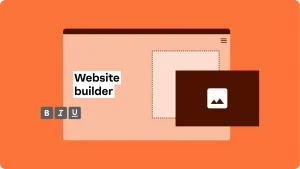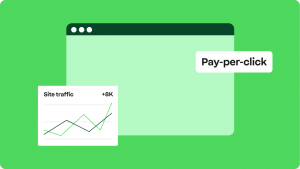Key takeaways:
- A product launch strategy is a step-by-step plan for bringing a new product to market and making it successful.
- A solid launch strategy helps you stand out in the market, reduce risks, excite customers, use resources wisely, boost sales, and maintain growth.
- To make a successful launch plan, you need to think about your goals, audience, messaging, channels, timeline, assets, and KPIs.
Bringing a new product to market is both a big opportunity and challenge for small business owners like you. Done right, you’ll capture attention, win customers, and create lasting momentum. Done wrong, even the best product can fade into the background and cause major losses.
That’s where a strong product launch strategy comes in. It provides a clear roadmap, aligns your team, and maximizes your marketing impact.
We’ll show you how to build a winning product launch strategy that sets your brand apart and drives long-term success.
What is a product launch strategy?
A product launch strategy is a step-by-step plan for how your product enters the market, how you position it to your target customers, and how your marketing plan ensures lasting success. It covers research, messaging, team alignment, promotion, and post-launch activities.
In other words, it’s the roadmap that makes the difference between a product that takes off and one that fades into the background.
Let’s put this into perspective. Imagine you’ve spent months developing a productivity app with innovative features that genuinely save people time. You launch it on the app store without preparation, hoping the product will “speak for itself.”
A few downloads trickle in, but nothing close to the adoption you expected. Why? Without a product launch strategy, your app never reached the right audience, your message didn’t cut through the noise, and your marketing efforts lacked coordination.
A launch strategy is important since it ensures the market notices, understands, and adopts your product.
Why do new product launches fail?
Studies often cite that around 95% of new products fail out of 30,000 each year. That’s a sobering statistic that emphasizes how much is at stake when you bring something new to market.
So why do these product launches fail? Here are the most common reasons:
- Inadequate market research. Too many companies build what they think people want without really checking the demand. Without insights into customer pain points, preferences, and buying behavior, even well-designed products can flop.
- Weak messaging. If your audience doesn’t understand what the product does, why it matters, or how it’s different, they won’t buy. Jargon-heavy or vague messaging kills excitement.
- Ignoring post-launch strategies. Many brands treat launch day as the finish line. They pour resources into the announcement, then go quiet. Without sustained marketing, customer support, and product updates, momentum fizzles out.
- Underestimating competition. Failing to track what competitors are doing can blindside you. If your product doesn’t offer a clear advantage or if competitors out-market you, your launch gets drowned out.
- Poor planning and execution. Some launches fail simply because teams underestimate the complexity: missing deadlines, failing to align marketing and sales, or running out of budget. Execution gaps quickly undermine even a strong product.
Benefits of a new product launch strategy
Product launch failures can be avoided with a proper launch strategy. Let’s list down the advantages of being properly prepared for your plan:
- Clear direction and alignment. A well-defined strategy aligns your marketing, sales, product, and support teams around the same goals. Everyone knows the timeline, target audience, and key messages, reducing confusion and last-minute chaos.
- Stronger market positioning. Your strategy ensures your product is introduced with a compelling story and clear value proposition. Instead of just “releasing” something new, you position it as the solution customers have been waiting for.
- Reduced risk of failure. By doing the groundwork such as market research, competitor analysis, and customer validation, you avoid costly missteps like launching the wrong product at the wrong time.
- Increased customer excitement and engagement. Planned pre-launch teasers, announcements, and campaigns build anticipation. Customers become aware of your product while feeling like part of the journey. This increases their emotional connection and likelihood to purchase.
- Optimized use of resources. A structured plan helps you prioritize where to allocate your budget and efforts instead of wasting them on scattered activities.
- Higher sales and faster adoption. When your story, promotion, and customer experience align, you create a smooth path to purchase. This drives stronger early sales, faster adoption, and positive word-of-mouth.
- Sustainable growth post-launch. A good strategy carries through with post-launch campaigns, customer onboarding, and feedback loops. You keep up your momentum and lead towards long-term success.
Types of product launches
Before you start planning, know what kind of product launch you want to do. Here’s a list of all the launch types your marketing team may consider:
| Launch type | Description | Best for |
|---|---|---|
| Soft launch | Low-key release to a small audience; gathers feedback and reduces risk. | Testing ideas before a wider release. |
| Minimal launch | Mid-scale launch with moderate visibility; more impact than a soft launch but resource-friendly. | Making a market impression without overspending. |
| Full-scale launch | High-profile release with big campaigns, events, and media coverage. | Major products expected to disrupt or dominate the market. |
Choosing between a soft, minimal, or full-scale launch depends on your goals, resources, and timing. But with proper planning and marketing, each type can create meaningful impact.
How to create a successful product launch strategy
To turn your idea into a successful market debut, here’s a step-by-step approach to the product launch process:
- Define your objectives
- Know your audience
- Conduct market research
- Craft your positioning and messaging
- Build a launch timeline
- Choose your marketing channels and tactics
- Prepare your launch assets
1. Define your objectives
Every successful launch starts with a clear purpose. Ask yourself: What does success look like for this product?
- Are you aiming to build brand awareness?
- Do you want to drive pre-orders or sign-ups?
- Is the goal to grow market share?
When Apple launches a new iPhone, its objective isn’t just sales; it wants to keep its brand’s relevance and compete with rivals such as Samsung. Once you’ve got tangible results you want to see after launch, you can create your key performance indicators (KPIs) to track your objectives.
Tip: Don’t make grand and vague goals. Create specific, measurable, achievable, relevant, time-bound (SMART) goals.
2. Know your audience
A product launch only works if it resonates with the right people. Define who your product is for and what problems it solves.
- Think about their demographics, pain points, and motivations. With a concrete personality, pretend like this is an actual customer you’ll encounter. You can even give them names to make it more realistic.
- Identify where your audience spends time online: Instagram, LinkedIn, TikTok, Reddit, or industry forums.
- Understand what motivates them: price, convenience, exclusivity, or brand values.
3. Conduct market research
Market research answers: Is there really a demand for this product? After all, what’s the point of making a new product if nobody needs it? If you’re sure of your product’s demand, you can reduce the risk of failure.
Make sure to:
- Study competitors. Check how they position similar products, particularly their strengths and weaknesses. You can exploit those gaps with your new product.
- Gather customer insights. Use surveys, focus groups, interviews. You want to know their real opinions from real experiences.
- Track trends. Use keyword research tools like Google Trends and AnswerThePublic, and social listening platforms like Sprout Social and BuzzSumo, to see your target audience’s online activity. Pay attention to how they’re talking about brands and product categories similar to your product.
- Test concepts. Run small ad campaigns or pre-launch waitlists to gauge interest.
4. Craft your positioning and messaging
Your unique value proposition (UVP) explains why customers should choose your product, highlighting what makes your solution different, better, or more desirable.
Here’s a solid formula for creating your messaging: [Target Audience] + [Problem You Solve] + [How You’re Different] = UVP
Let’s say you’re a skincare brand that wants to launch a new line of product. Here’s an oversimplified breakdown on how you can make your own UVP:
- Target audience: Gen Z consumers
- Problem you solve: Tired of harsh, chemical-filled skincare products
- How you’re different: Sustainable, plant-based formulas with compostable packaging, no animal-testing.
UVP: “For Gen Z consumers frustrated with toxic skincare, our line delivers clean, plant-based formulas in compostable packaging—so you can glow without guilt.”
When you have your UVP ready, follow these tips to utilize the most of it:
- Put it at the top of your landing page.
- Include it in your press release intro.
- Make sure your sales team memorizes it.
- Repeat it across all channels—social media, email campaigns, ads, and product packaging.

5. Build a launch timeline
A well-structured timeline prevents chaos and ensures your team hits milestones. Break it into three phases:
| Phase | Key activities | Sample scenarios |
|---|---|---|
| Pre-launch | Teasers content creation press outreach beta testing | A SaaS startup releases sneak-peek screenshots on LinkedIn, builds a waitlist landing page, and invites 200 users to a private beta. |
| Launch day | Big reveal press release coordinated campaigns | An eCommerce brand hosts a live Instagram event to reveal its new product, sends a launch email to subscribers, and coordinates influencer posts to go live the same morning. |
| Post-launch | Customer engagement feedback collection continuous marketing | A fitness app runs follow-up email campaigns with onboarding tutorials, collects app store reviews, and shares customer success stories on social media. |
Sample timeline:
- 3 months before → Begin teasers + influencer seeding.
- 1 month before → Announce launch date, open pre-orders/waitlist.
- Launch day → Host live event, drop product across all channels.
- 1 month after → Publish case studies, testimonials, follow-up campaigns.
Tip: Keep your team updated on your target schedule to keep everything on track. Use trackers and sprint boards to stay on top of everyone’s activities.
6. Choose your marketing channels and tactics
The best channel depends on your audience. For instance, if you’re targeting Gen Zs, then you’re probably be on social media sites than traditional channels. Similarly, professional finance brokers probably won’t look to influencers for trade recommendations and advice.
However, most launches use a mix of all channels to cover all bases. Each type has its own appeal:
- Press releases and media outreach for credibility and reach.
- Social media teasers to build hype with countdowns, behind-the-scenes, or sneak peeks.
- Influencer partnerships to leverage trust and larger audiences.
- Paid ads to amplify visibility quickly.
- Email campaigns to nurture your warmest audience directly.
- Events and webinars to showcase product live, answer questions, and demo features.
Tip: The key is knowing which channel to focus on. You don’t want to waste resources on ineffective strategies, but it’s still smart to cover all your bases just in case.
7. Prepare your launch assets
Decide on what kind of launch assets you want to release, then create reasonable deadlines for your team. Have everything ready before launch day to avoid scrambling. Generally, the assets you’d want are:
- Product photos and videos
- Demo/tutorial videos
- FAQs and troubleshooting docs
- Press kit (logos, product sheets, high-res images)
- Landing pages optimized for conversions
- Email templates for pre-launch, launch day, and post-launch follow-ups
A product launch strategy is a structured process that takes you from idea validation to sustained growth. The more you prepare, test, and adjust, the higher your chances of success.
Comprehensive success metrics for a new product launch
Part of the planning is also knowing how to measure success. Here are key metrics to include in your strategy so you know what’s working and what needs improvement:
| Category | Metrics | Why it matters |
|---|---|---|
| Sales performance | -Total sales revenue -Units sold -Sales growth rate | Measures direct financial success and launch-day/early adoption performance. |
| Customer acquisition | -Number of new customers -Customer acquisition cost (CAC) -Conversion rates from leads to customers | Tracks how effectively your marketing efforts convert interest into paying customers. |
| Market share | -Percentage of market share gained -Competitive positioning | Shows how your product performs against competitors and if you’ve expanded your market footprint. |
| Customer engagement | -Website/campaign page traffic -Social media engagement (likes, shares, comments) -Email open & click-through rates | Indicates how much awareness and excitement your launch generated across different channels. |
| Product adoption | -Number of product sign-ups/registrations -Adoption rate among target users | Evaluates whether customers are actually using the product, not just buying it. |
| Customer satisfaction | -Net Promoter Score (NPS) -Customer feedback and reviews -Support ticket volume and resolution time | Reveals how customers feel post-launch and whether they’ll recommend your product. |
| Brand awareness | -Social media mentions and sentiment -Media/PR coverage -Website and social follower growth | Tracks visibility and buzz your product generated beyond direct sales. |
| Return on investment (ROI) | -ROI from marketing and promotional activities -ROI on total launch spend (development + marketing) | Determines profitability and efficiency of your launch efforts. |
| Product performance | -User engagement with key features -Product metrics (downloads, usage frequency, feature adoption) | Shows how well the product itself delivers value and fits customer needs. |
| Retention and strategic KPIs | -Customer retention rate -Churn rate -Completion of strategic goals | Measures long-term impact, not just short-term buzz. |
The 4 Ps of product launch
The 4 Ps form the foundation of any marketing mix, and they’re especially important when planning a product launch. Let’s take your product launch up a notch by establishing 4 important P principles:
- Product → Solve a real problem
A successful launch starts with a product that genuinely addresses customer needs. It should offer unique features, benefits, or innovations that set it apart from competitors. Ask: Does this product solve a pain point better, faster, or more affordably than existing solutions? If yes, you’re setting yourself up for strong adoption.
- Price → Align with value and market
Price signals your value and positioning. Too high, and you risk alienating your audience; too low, and you may undermine perceived quality. During launch, pricing strategies, like introductory offers, discounts, and bundles, can create urgency and attract early adopters.
- Place → Sell where your audience shops
Distribution matters. Your product should be available where your audience already spends time and money. For eCommerce, that could mean platforms like Amazon, Shopify, or Etsy. For SaaS, your “place” might be app stores or direct website sign-ups. For physical goods, it could be retail stores or pop-ups. The right place ensures accessibility and convenience.
- Promotion → Spark awareness through storytelling and marketing
Even the best product won’t succeed if nobody knows about it. Promotion is about building buzz and driving demand through multiple channels: PR, social media, email campaigns, influencer partnerships, and paid ads. Strong storytelling—explaining why this product, why now—creates excitement and emotional connection.
Frequently asked questions
A product launch is the introduction of a new product to the market, designed to generate attention and drive initial sales.
A product launch strategy is the roadmap that outlines how you’ll present, promote, and deliver your product to your target customers.
Research, goals, messaging, plan, pre-launch, launch day, follow-up. Each step helps ensure your launch is structured and effective.
Product, Price, Place, Promotion. These elements guide how a product is positioned and marketed.
Market penetration, product development, market development, and diversification. These strategies support different business growth goals.
Define goals, audience, messaging, channels, timeline, assets, and KPIs. A clear plan keeps your team organized and focused.
Do you really need a new product launch?
Not every product update deserves a full-scale launch. But there are times when introducing something new—or reintroducing it with fanfare—can boost visibility, sales, and customer loyalty.
Here’s a checklist to know if you need a new product launch:
- You’re entering a new market or audience segment.
- You’re releasing a completely new product.
- Your product has undergone a major update.
- Your competitors are gaining ground.
- You want to reignite customer excitement.
- You’re aligning with a key season or event.
- You’re ready to scale.
Launch a new product successfully with the right strategy
It all comes down to having the right strategy. Do your research, craft a clear story, plan your announcement, and keep the momentum going after launch. That’s how you stand out and build real traction.
And if you really want to get your product in front of the right people fast, add Network Solutions’ Pay-per-click Ads into the mix. They’ll help you reach the exact audience you’re after, right when they’re searching—giving your launch the extra push it needs to take off.




